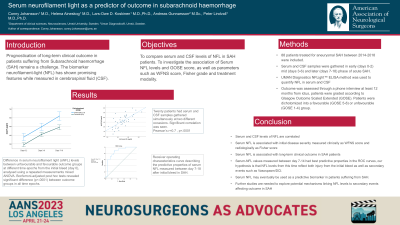Serum neurofilament light as a predictor of outcome in subarachnoid haemorrhage
Serum Neurofilament Light as a Predictor of Outcome in Subarachnoid Haemorrhage
Friday, April 21, 2023


Conny Johansson, MD (he/him/his)
Resident in Neurosurgery, Ph.D Student
Umeå University Hospital
ePoster Presenter(s)
Introduction: Prognostication of clinical outcome in patients suffering from spontaneous subarachnoid haemorrhage (SAH) is a challenge. There are no biochemical markers in routine use that can aid in prognostication. Neurofilament light (NFL) measured in cerebrospinal fluid (CSF) have been associated with clinical outcome in previous studies.
Methods: We conducted an observational cohort study including 88 patients who were treated for SAH at Umeå University Hospital between 2014-2018. Serum and CSF samples were analysed using an ELISA method to quantify NFL levels. Outcome was assessed using Glasgow Outcome Scale Extended and dichotomized into a favourable or unfavourable outcome. Differences in NFL levels between outcome groups and relation between CSF and serum NFL levels were analysed.
Results: A significant correlation between serum and CSFNFL levels could be seen. Serum NFL were higher in the unfavourable outcome group in all epochs of SAH. NFL correlated to initial disease severity measured as World federation of neurosurgical societies scale. Serum NFL in the late phase displayed the best predictive potential in a receiver operation characteristics curve analysis.
Conclusion : Levels of NFL in serum and CSF are correlated. Early NFL levels seem to reflect initial tissue damage and NFL levels in the late phase may reflect secondary events such as vasospasm/delayed cerebral ischemia (DCI). Serum levels of NFL may be used as a prognostic marker for clinical outcome in SAH.
Methods: We conducted an observational cohort study including 88 patients who were treated for SAH at Umeå University Hospital between 2014-2018. Serum and CSF samples were analysed using an ELISA method to quantify NFL levels. Outcome was assessed using Glasgow Outcome Scale Extended and dichotomized into a favourable or unfavourable outcome. Differences in NFL levels between outcome groups and relation between CSF and serum NFL levels were analysed.
Results: A significant correlation between serum and CSFNFL levels could be seen. Serum NFL were higher in the unfavourable outcome group in all epochs of SAH. NFL correlated to initial disease severity measured as World federation of neurosurgical societies scale. Serum NFL in the late phase displayed the best predictive potential in a receiver operation characteristics curve analysis.
Conclusion : Levels of NFL in serum and CSF are correlated. Early NFL levels seem to reflect initial tissue damage and NFL levels in the late phase may reflect secondary events such as vasospasm/delayed cerebral ischemia (DCI). Serum levels of NFL may be used as a prognostic marker for clinical outcome in SAH.
